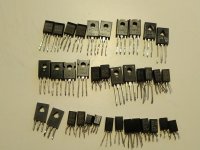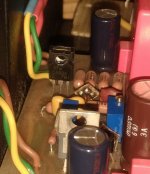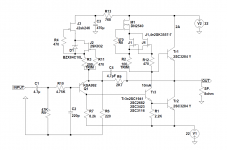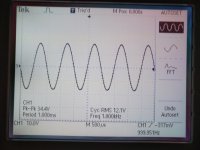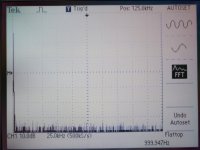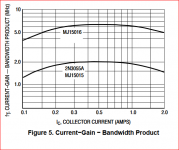I did look for that and didn't find it. Naim used that series. These days searches don't always give all choices.
Shaftesbury can't be far from North Devon except by road? Getting anywhere isn't quick on country roads.
Shaftesbury can't be far from North Devon except by road? Getting anywhere isn't quick on country roads.
Many years ago, Practical Wireless magazine author and diyAudio member Graham Maynard (R.I.P) wrote a series of controversial (as in hotly disputed) articles about his personal JLH adventures titled "Class A Imagineering". It was published in a number of issues of Electronics and Wireless World Magazine (2003?). Interestingly, he insisted on 2SC3421Y as the best available semi for the VA/phase splitter transistor. I won't add to the arguments but consideration might lead to a more complete understanding of what's actually best sounding/performing there if we follow up on the wealth of knowledge already collected on the amplifier over 50 years.
It could also save a lot of time guessing for the umpteenth time about the same basics of the design when a little reading and research of our own can supply most if not all the answers. Follow up on the leads for yourselves.
Here's one of jcx's threads that discuss Graham's design and some of the choices. Graham's Class A/JLH output
It could also save a lot of time guessing for the umpteenth time about the same basics of the design when a little reading and research of our own can supply most if not all the answers. Follow up on the leads for yourselves.
Here's one of jcx's threads that discuss Graham's design and some of the choices. Graham's Class A/JLH output
I did look for that and didn't find it. Naim used that series. These days searches don't always give all choices.
Shaftesbury can't be far from North Devon except by road? Getting anywhere isn't quick on country roads.
I might give the ZTX a spin. Yes, North Devon not far, but as you say takes ages to drive anywhere!!
Many years ago, Practical Wireless magazine author and diyAudio member Graham Maynard (R.I.P) wrote a series of controversial (as in hotly disputed) articles about his personal JLH adventures titled "Class A Imagineering". It was published in a number of issues of Electronics and Wireless World Magazine (2003?). Interestingly, he insisted on 2SC3421Y as the best available semi for the VA/phase splitter transistor. I won't add to the arguments but consideration might lead to a more complete understanding of what's actually best sounding/performing there if we follow up on the wealth of knowledge already collected on the amplifier over 50 years.
It could also save a lot of time guessing for the umpteenth time about the same basics of the design when a little reading and research of our own can supply most if not all the answers. Follow up on the leads for yourselves.
Here's one of jcx's threads that discuss Graham's design and some of the choices. Graham's Class A/JLH output
Thanks Ian, I hadn't seen this thread so will start reading.
At last the most interesting part of the amplifier gets thought about. Sadly very few easy to get options exist now. I suggest we all buy a big bag of BC327/337 when we can. They can be used with a NE5534 via the compensation pins to make the world's lowest hiss preamp. I have the circuit. It's an older 741 Idea only better. 0.6 nV/root Hz. They are do anything devices. The 5534 is already good. The circuit is no more complex in signal path terms as the input transistors get turned off. They work as switching transistors if you need to.
Ah come on Nigel, don't keep us in suspenders - show us the circuit 🙂
Cheers from a rather warm and comfortable Aylesbury.
Mike
Cheers from a rather warm and comfortable Aylesbury.
Mike
When I talk about fast transistors for JLH69 I didn’t get to that overnight. It took more than a year of desoldering - soldering transistors, oscilloscope testing and hearing tests.
The scheme I used is for dual power supply with two CCS added. JLH himself wrote somewhere that it would be good to try FET as CCS for the input transistor, that's where it all started. For Tr3 due to the higher current I used DN2540. It should be noted that Tr3 is the most important transistor in JLH69 and must be with a higher hFE and a smaller Cob.
The figure shows only one part of the transistors tested for Tr3, the other figure is the test with 2SC4934 as Tr3 and the final circuit.
The scheme I used is for dual power supply with two CCS added. JLH himself wrote somewhere that it would be good to try FET as CCS for the input transistor, that's where it all started. For Tr3 due to the higher current I used DN2540. It should be noted that Tr3 is the most important transistor in JLH69 and must be with a higher hFE and a smaller Cob.
The figure shows only one part of the transistors tested for Tr3, the other figure is the test with 2SC4934 as Tr3 and the final circuit.
Attachments
Use of FET
The attached file shows one example by JLH this was for a phono stage with +/- 50 volt supply rails which is no typing mistake. The FET working voltage needed to be 50 volts. The 2N5460 is not that good but I have used it for illustration. He used some other variations in audio instrument designs.
The attached file shows one example by JLH this was for a phono stage with +/- 50 volt supply rails which is no typing mistake. The FET working voltage needed to be 50 volts. The 2N5460 is not that good but I have used it for illustration. He used some other variations in audio instrument designs.
Attachments
Ah come on Nigel, don't keep us in suspenders - show us the circuit 🙂
Cheers from a rather warm and comfortable Aylesbury.
Mike
I know Aylesbury rather well although mostly passing through.
I think you mean the op amp plus buffer? I need to stop thinking about it and do it. I am not aiming for very low distortion. More about sensible compromises. One Idea I have is to use a thermal switch to knock it into class AB if it's a very hot day. An override switch to make it class AB when wanted. It's a crude system which should be good enough.
The compromise I hope to succeed with is a low enough output impedance. One of Rod Elliott's El Cheapo designs is similar to how it might look. He shows a single transistor input buffer. I feel an op amp might be better. The important thing is to simplify where possible. I assume I will use TIP142/147 if only to start. BC337-40 should easily drive them. Bias by 3 X 1N4007 diodes and resistor . I have some exotica which I will resist using. Some may be fakes.
One Idea that might work is a complimentary feedback pair of BC337/IRF9530 and BC327/IRF530. This is a version of JLH class AB design. That should have low distortion.
How to build these designs is rather like my new diet. I act like food is in short supply. I focus on easy to do healthy foods. I think I never have eaten better although it's a bit repetitive. Sardines are fantastic. I am not compensating for Covid. Just saying combine reality with practicality. Especially shop where it's least hassle.All of that applies to building electronics.
In the attached file adding a resistor in parallel with R3 will reduce the Class A operating current somewhat which would reduce heat dissipation.
This could be operated by a normally open contacts thermal switch at a suitable temperature.
This is part of an op.amp concept version of the JLH I drew up a few years ago making use of the MJL3281 transistors high gain bandwidth product to increase the closed loop gain by roughly 50 %.
I don't have much time to build projects these days. Even though I am retired I have become increasingly involved in family care due to medical issues - to the point where the motivation to get started is not there.
This could be operated by a normally open contacts thermal switch at a suitable temperature.
This is part of an op.amp concept version of the JLH I drew up a few years ago making use of the MJL3281 transistors high gain bandwidth product to increase the closed loop gain by roughly 50 %.
I don't have much time to build projects these days. Even though I am retired I have become increasingly involved in family care due to medical issues - to the point where the motivation to get started is not there.
Attachments
Thanks for sharing that, especially about the medical issues. The BBC did programs about who cares for the carers. As we get older many face similar complex situations. In my case I remember being all on my own or so it seemed. Someone told me to be depressed in that situation was a healthy reaction. You know that helped! In other words depression is a coping reaction forcing you to fight. It can be something trivial that helps. I will share something along these lines. I have a cousin I don't really know. She recently wrote to me. She was always the Johanna Lumley type. I wondered if some well meaning relative thought I needed a friend. I couldn't be more wrong. She needed a friend. It seems so unlikely as she seems she should be so successful. She is the only person I write letters to. She doesn't even have a phone!
I just looked up MJL3281. On the face of it not unlike 2SC5200 except it seems to be what some call a sustained beta device. That is the gain isn't so dependent on current. Highly unusual if understanding why others are not like this. The Cob is 600pF. That might help as it is a bandwidth limit if the driver can't supply it. I seem to remember TIP3055 is lower but could be wrong. To have more open loop gain at real auidio frequencies and less at medium wave radio frequencies is useful. This might be the best fast transistor that is slow enough to work. I will leave it to others to find the facts. The sharp minded might say why not add 220pF to 2SC5200. Check the current reaches stasis if you do. I have doubts.

This is better than it looks Mike. It's quite powerful and could be class A. The gain can be set as a buffer class A and small gain class AB.These FET's might be marginal. Ones with Ron of about 0R5 might have the ideal bias stasis. Distortion is similar to JLH. As a buffer likely better. The buffer also has lower output impedance. If it was set as 1 watt class A I suspect it would be very good. If you push too much current through these FET the sound sometimes goes a bit limp. C2 is a nice idea. NOP/COG type. C4 although common to 1930s circuits is a reasonable thing to do.
The FET is the easier device to use. It seems to have high Cgs than bipolar parasitic capacitance. That in a PP design is not very important as it is bootstraped to the loudspeaker. As a unity gain stage the output signal is inphase with the gate singnal and almost equal. Hence Cgs is largely ignored. Cgd is another story.
I hope you can read the original address.
https://cpc.farnell.com/on-semiconductor/mj15016g/transistor-pnp-to-3/dp/SC09270?st=transistors
This is very close to MJL3281 in everything at a bargain price. It would be a PNP version. The MJ15015 NPN is a bit boring. 18 Mhz and good Cob.
This is very close to MJL3281 in everything at a bargain price. It would be a PNP version. The MJ15015 NPN is a bit boring. 18 Mhz and good Cob.
Yes everyone talks about mjl3281 being a great audio transistor but there are quite a few reports of it causing oscillation. I don't understand that is the direct cause of this but speed and layout seem to be cited as potential factors.
Mj15003 seems to be seen as the safe alternative to 2N3055 for jlh.
The mj15016 looks interesting for sure. I haven't really come across people using PNP outputs in jlh. Would be interesting to hear if anyone has tried this transistor. 18MHz seems like middle ground. The question is how fast is too fast for this circuit. Again I guess it will depend on layout and other components etc.
Mj15003 seems to be seen as the safe alternative to 2N3055 for jlh.
The mj15016 looks interesting for sure. I haven't really come across people using PNP outputs in jlh. Would be interesting to hear if anyone has tried this transistor. 18MHz seems like middle ground. The question is how fast is too fast for this circuit. Again I guess it will depend on layout and other components etc.
One of us has one. He loves it. I could imagine the MJ15016 could be marginal if no oscilloscope available.
TIP3055is not bad. It's not really a 2N3055 as was. Arcams Chris' Evans told me how good it was when buying A60 serial number 301. My first ever cheque. £91.92 as it was trade price. I listen to Beatles Abbey Road via a Rega Planar 3 using Spendor BC1s at Frenches Mill in Cambridge. I never regretted that.
TIP3055is not bad. It's not really a 2N3055 as was. Arcams Chris' Evans told me how good it was when buying A60 serial number 301. My first ever cheque. £91.92 as it was trade price. I listen to Beatles Abbey Road via a Rega Planar 3 using Spendor BC1s at Frenches Mill in Cambridge. I never regretted that.
Ha! Nothing is like the 2N3055 as was. The current epi (ON Semi) device seems to be quite close to the TIP3055 though.
Member
Joined 2009
Paid Member
These days searches don't always give all choices.
Funny you should mentioned that as I’ve noticed a real decline in the effectiveness of Google searches the past few months.
I listen to Beatles Abbey Road via a Rega Planar 3 using Spendor BC1s at Frenches Mill in Cambridge. I never regretted that.
Ah the sublime album. That last orchestral section after the guitar solos and Paul McCartney's last vocal line always send shivers down my spine when ever I hear it - it begs one to turn the volume control up to 11.
I am not too happy about the latest remix of that. It was perfect and masterful as it was and IIRC, Geoff Emerick and Phil McDonald got an Grammy for it. You don't go and repaint the Mona Lisa.
Nigel - thanks for that circuit diagram - I sent you a PM about it.
Kind regards
Mike
Last edited:
Yes everyone talks about mjl3281 being a great audio transistor but there are quite a few reports of it causing oscillation. I don't understand that is the direct cause of this but speed and layout seem to be cited as potential factors.
Mj15003 seems to be seen as the safe alternative to 2N3055 for jlh.
The mj15016 looks interesting for sure. I haven't really come across people using PNP outputs in jlh. Would be interesting to hear if anyone has tried this transistor. 18MHz seems like middle ground. The question is how fast is too fast for this circuit. Again I guess it will depend on layout and other components etc.
The working capital is the gain bandwidth product - like how much to devote to closed loop gain and how much to allow for negative feedback - so if the closed loop gain is increased that reduces the level of feedback.
As far as MJ15016 is concerned the gbp is not 18MHz as the table suggests. At 1A it is 6MHz according to the accompanying graph.
Attachments
- Home
- Amplifiers
- Solid State
- JLH 10 Watt class A amplifier
